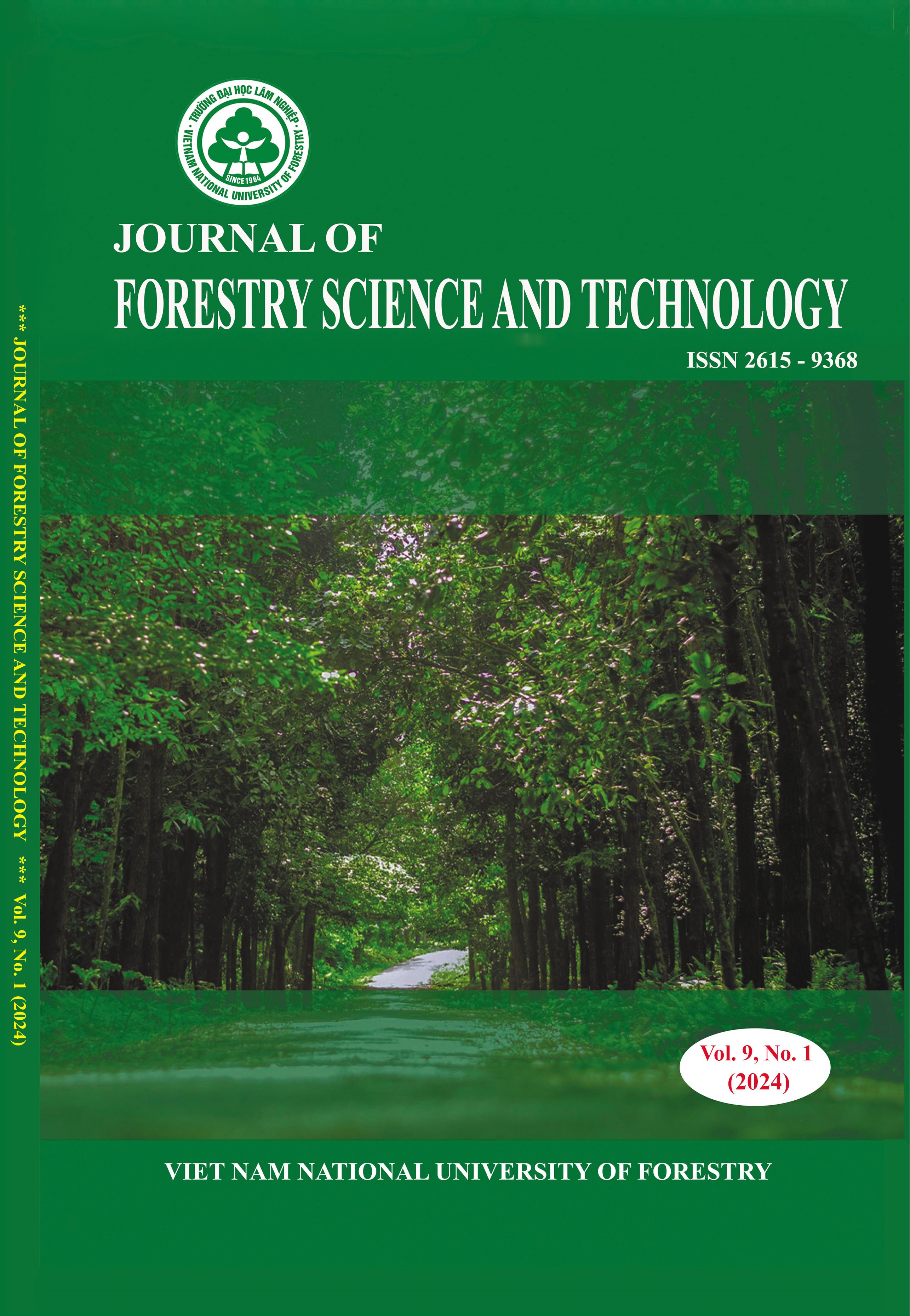A study on processing bottled banana-flavored herb tea
DOI:
https://doi.org/10.55250/Jo.vnuf.9.1.2024.003-011Abstract
Herb tea is tending to be consumed widely and increasingly in the world. In Vietnam, banana is one of the most popular fruits, but their peels are often wasted which can be reproduced in food processing. The purpose of this study was to determine the combination of banana-flavored water mixed with other herb extraction to create a kind of herbal drink meeting demand’s consumers. Therefore, banana peels were extracted directly in boiling water to create steam and condense water with a strong banana flavor. The optimal volume of banana-flavored water was 25 mL added into 100 mL herbal extract water. Among seven studied herbs, licorice with the number of 2 branches was accepted the most by panelists for herb tea’s sweetness and valued 3.8 for the taste sensory score in the 5 -point Hedonic scale. In addition, saffron with 3 branches was the best coloring agent for bright yellowness, determined 4.2 for the color sensory score. On the other hand, jujube (1 gram) was the best appropriate herb for the best flavour, well mixed with other herbs to produce the best acceptance by major panelists (the total sensory score of 14.6). The final herb tea product made by the selective recepi is potential to supply for the market a new healthy herbal drink.
References
. Yaman, C. (2020). Lemon balm and sage herbal teas: Quantity and infusion time on the benefit of the content. Food Sci. Technol. 44: 1-11. DOI: 10.1590/1413-7054202044023220.
. Poswal, F.S., Russell, G., Mackonochie, M., MacLennan, E., Adukwu, E.C., & Rolfe, V. (2019). Herbal Teas and their Health Benefits: A Scoping Review. Plant Foods Hum. Nutr. 74(3): 266-276. DOI: 10.1007/s11130-019-00750-w.
. Minh, N.P., Yen, N.K., Phuong, N.T.H., Tan, T.V., & Hua, T.K. (2019). Investigation of Herbal Tea Production from Centella Asiatica Leaf. Plant Foods Hum. Nutr. 11(3): 755-758.
. Pohl, P., Dzimitrowicz, A., Jedryczko, D., Szymczycha-Madeja, A., Welna, M., & Jamroz, P. (2016). The determination of elements in herbal teas and medicinal plant formulations and their tisanes. J. Pharm. Biomed. Anal. 130: 326-335. DOI: https://doi.org/10.1016/j.jpba.2016.01.042.
. Prchalová, J., Kovařík, F. & Rajchl A. (2017). Evaluation of the quality of herbal teas by DART/TOF-MS. J. Mass Spectrom. 52(2): 116-126. DOI: https://doi.org/10.1002/jms.3905
. Thy, V.B. & Dung, N.C. (2022). A study on the production of bottled saffron and stevia herbal tea. Vietnam Trade and Industry review. 5(3): 352-359.
. Vu, D.C. & Alvarez, S. (2021). Phenolic, Carotenoid and Saccharide Compositions of Vietnamese Camellia sinensis Teas and Herbal Teas. Molecules. 26(6496): 1-14.
. Cheng, Y.C., Sheen, J.M., Hu, W.L., & Hung, Y.C. (2017). Polyphenols and Oxidative Stress in Atherosclerosis-Related Ischemic Heart Disease and Stroke. Oxid Med. Cell. Longev. 8526438: 1-16. DOI: https://doi.org/10.1155/2017/8526438
. Cao, S.Y., Zhao, C.N., Gan, R.Y., Xu, X.Y., Wei, X.L., Corke, H., Atanasov, A.G., & Li, H.B. (2019). Effects and mechanisms of tea and its bioactive compounds for the prevention and treatment of cardiovascular diseases: An updated review. Antioxidants. 8(6), 166: 1-17.
. Anilkumar, K. (2016). Sourcing sweet healing: Unveiling the medicinal potentials of Scoparia dulcis in contemporary healthcare: A review study. Int. J. Chem. Stud. 4(1): 144-147.
. Yang, R., Wang, L.Q., Yuan, B.C., & Liu, Y. (2015). The Pharmacological Activities of Licorice. Planta Med. 81(18): 1654-1669. DOI: https://doi.org/10.1055/s-0035-1557893.
. Jin, X. (2018). Jujuba-Ziziphus jujuba. in Exotic Fruits. Academic Press. 263-269.
. Ji, X., Peng, Q., Yuan, Y., Shen, J., Xie, X. & Wang, M. (2017). Isolation, structures and bioactivities of the polysaccharides from jujube fruit (Ziziphus jujuba Mill.): A review. Food Chem. 227: 349-357. DOI: https://doi.org/10.1016/j.foodchem.2017.01.074
. Yeung, A.W.K., Tzvetkov, N.T., El-Demerdash, A., Horbanczuk, O.K., Das, N., Pirgozliev, V., Lucarini, M., Durazzo, A., Souto, E.B., Santini, A., & Prasad, H. (2021). Apple polyphenols in human and animal health. Anim. Sci. Pap. Rep. 39(2): 105-118.
. Neelam, K., Dey, S., Sim, R., Lee, J., & Au Eong, K.G. (2021). Fructus lycii: A Natural Dietary Supplement for Amelioration of Retinal Diseases. Nutrients. 13(1): 246.
. Poswal, F.S., Russell, G., Mackonochie, M., MacLennan, E., Adukwu, E.C. & Rolfe, V. (2019). Herbal Teas and their Health Benefits: A Scoping Review. Plant Foods Hum. Nutr. 74: 266-276.
. Elhawary, E.A., Mostafa, N.M., Labib, R.M., & Singab, A.N. (2021). Metabolomic Profiles of Essential Oils from Selected Rosa Varieties and Their Antimicrobial Activities. Plants. 10(8): 1721.
. Mourya, N.M.N., Bhopte, D.B.D., & Sagar, R.S.R. (2017). A review on Jasminum sambac: A potential medicinal plant. Int. J. Indig. Herbs Drugs. 2(5): 13-16.
. Lam, T.M.L., Tu, Q.T., & Le, M.T. (2022). Research and creating soap from Cocos Nucifera L. and Chrysanthemum Indicum L. oil. Scientific Journal of Saigon University. 8(2): 51-63.
. Duong, D.T.T., Luu, C.T., Tham, D.T., Huong, T.T.B., & Hung, V.V. (2022). Effect of planting distance on growth, development, and yield of Musa accuminata L. in vitro cultivated in Trang Bom district, Dong Nai province. Biotechnology and Seedling, Journal of Forestry Science and Technology. 3(3): 12-22.
DOI: https://doi.org/10.55250/jo.vnuf.2022.3.012-022
. Mohd Zaini, H., Roslan, J., Saallah, S., Munsu, E., Sulaiman, N.S., & Pindi, W. (2022). Banana peels as a bioactive ingredient and its potential application in the food industry. J. Funct. Foods. 92: 105054.
. Oduro, I., Twumasi, P., Tandoh, M., Ankar, B., & De., H. (2013). Formulation and sensory evaluation of herb tea from Moringa oleifera, Hibiscus sabdariffa and Cymbopogon citratus. J. Ghana Sci. Assoc. 15(1): 53-62.
. Chandraju, S., Venkatesh, R., Kumar, C.S.C., & Kumar, B.A. (2016). Estimation of reducing sugar by acid hydrolysis of sunflower (Helianthus annuus) husk by standard methods. Agric. Sci. 7(5): 322-325.
. National Science Committee (1990). TCVN 5165:1990 Foods - Method for enumeration of total aerobic bacteria. Institute of Nutrition – Ministry of Health.
. National Science Committee (1990). TCVN 5246-90 (ST SEV 6245-1988) Vaget bles and Fruits products. Determinations of ass-cobic acid content (Vitamin C) By tit ation and pnotome-try methods. Directorate for Standards, Metrology and Quality.
. Vietnam Ministry of Health (2009). QCVN 6-2:2010/BYT National technical regulation for soft drinks.









